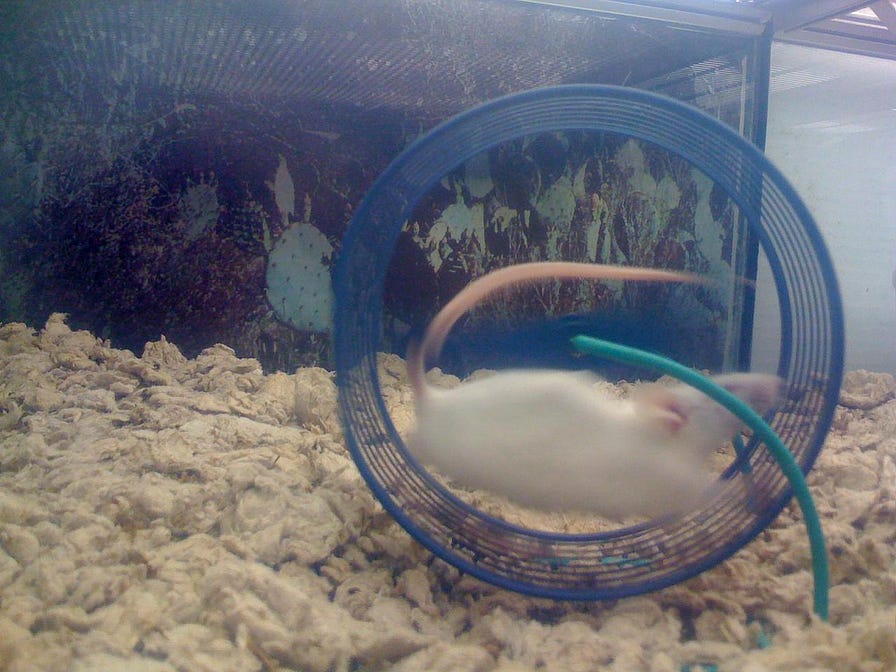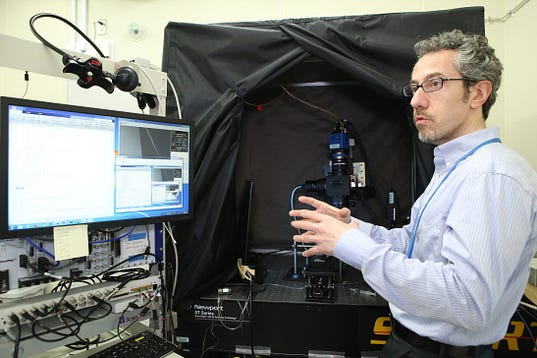Industry-academia collaboration builds the brain science assembly line
High-throughput automated experiments to address science's reproducibility crisis
June 8, 2017
Amanda Alvarez
This post originally appeared on Neurographic

Pet store mouse running on wheel. Image: Chris Devers, CC BY-NC-ND 2.0
When Henry Ford introduced the moving assembly line to his car factory in 1913, it was the culmination of improvements in efficiency and automation that compounded during the years of the Industrial Revolution. Now, in 2017, biomedical science is starting to catch on to the same idea. High-throughput genetic sequencing, for example, is hardly novel anymore, but other basic research that has relied on getting data from animals and cells, often one-at-a-time in lengthy experiments, has been slower to catch on. “As a postdoctoral researcher, I trained mice one by one — it took three months to train one mouse to do an experiment,” recalls Andrea Benucci. Now, as a research team leader at the RIKEN Brain Science Institute, Benucci is working on a Henry Ford-like solution, and has teamed up with Japanese laboratory equipment manufacturer O’hara to make it a reality.
They call it the ‘obox’. It’s an self-contained, computer-controlled system that lets mice train themselves on various behavioral tasks that test their vision, hearing and learning. One shelf that looks like a server rack can accommodate eight mouse cages at a time; the only human involvement required is switching the cages between day and night shifts. The mice direct themselves, entering the experimental box from their cage whenever they feel thirsty — they learn quickly that they can get water for performing experiments. It’s the mouse equivalent of a hamster wheel, but instead of aimless running mice rotate a tiny steering wheel with their paws to indicate, for example, whether images of gratings on a screen look vertical or horizontal. Mice also learn to keep their heads still without intervention from an experimenter — this, says Benucci, is the crucial advance compared with existing automated rodent training systems, and what makes the obox versatile for diverse experiments. At current capacity, in one day the system can train 48 mice, yielding about 10,000 data points. Benucci estimates that the obox system has reduced the person-time it takes to train one animal from 540 hours to 18 hours. But the savings in time are not the only benefit.
For scientific conclusions to be trustworthy, they need to be reproducible — any lab, anywhere in the world, should ideally be able to generate the same data using the same methods and protocols. The reality, however, is somewhat messier. From psychology to cancer biology, scientists have found that replicating some established results just isn’t possible, leading to a ‘reproducibility crisis’ in many scientific fields. The causes are myriad, from researchers who refuse to share the secret sauce of their methods to hyper-specialized chemicals, equipment or cell lines that are simply not available to all, to questionable use of statistics and small sample size (both human and animal).
That’s where the obox comes in. An automated system that is identical for all mice is a big step towards producing large-volume data that are uniform and uncontaminated by human involvement. “Experimenters can be clumsy and freak out the animals. Animals get stressed out when they are handled, so the progress can be very piecemeal,” says Benucci. What’s more, results from any labs using the system will be directly comparable, because all the experimental details will be the same. Indeed, Benucci is already in discussions with various international labs that are interested in setting up obox systems of their own. Of course, equipment isn’t the only thing needed for reproducibility: as many brain scientists are all too well-aware, the field lacks common data standards, hasn’t developed a culture of data-sharing and is awash with customized methods that make it hard to duplicate experiments across labs. But bringing automation and high-throughput devices to a field where work has traditionally been done painstakingly by-hand is already a small revolution.
Kiichi Ohara may be just the right kind of character to help usher in this change. He had ambitions of becoming a farmer but has effectively been in the lab equipment business his whole life, since his father started O’hara & Co. fifty years ago. Among the 300-or-so labs the company collaborates with, O’hara is known for its whimsical new year’s cards where the staff of six pose and dress up in different themes. This small group are dedicated to the needs of their clients, often responding to call and emails at midnight. “Many researchers are nocturnal,” observes Ohara. “We don’t get a lot of sleep.”

Andrea Benucci in the lab. Image: Tomoko Nishiyama/RIKEN Brain Science Institute
The company has collaborated with Benucci for about four years, first creating a prototype in 2015. RIKEN, Japan’s national science institute, has patented the obox system, which will very shortly be available through O’hara’s catalog. “I’ve been thinking about making mouse training automatic since forever, and I finally got the opportunity to do it,” says Benucci. Ohara says he was at first skeptical of Benucci’s idea, because it was unknown whether mice could learn to self-direct in a behavioral task. But they went ahead and built the system, and the benefits in long-term data gathering and consistency are now clear, Ohara says. “Scientists develop everything from scratch — protocols, software, hardware and devices,” says Ohara. “It’s my mission to help them, and there’s not that many people who can respond to those needs.”
Benucci’s ultimate goal isn’t technology development, but probing the functions of the mouse brain he is interested in — like conceptual reasoning — required pushing the experimental envelope. The obox isn’t just for studying mouse behavior: because it is modular, a screen can be augmented with microscopes and lasers to do brain recordings or optogenetics, the manipulation of genetically tagged neurons with bursts of light. “The expert mice can be placed in virtually any physiology system without a drop in their performance, says Benucci. “Nobody would be interested in this setup if trained mice behaved differently during neural recordings, which may happen if you train mice in one context but then record in another.” Systems like the obox are — to mix metaphors — upping the horsepower and reducing the noise in brain science, at a juncture when the field is finally going ‘big’ in terms of data, collaborations, and computational power.